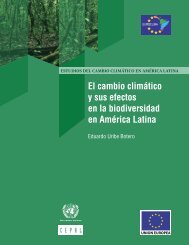Inequality and Climate Change Inégalité et changement climatique
Inequality
Inequality
Create successful ePaper yourself
Turn your PDF publications into a flip-book with our unique Google optimized e-Paper software.
Ramos: Introduction 5<br />
The transgression of plan<strong>et</strong>ary boundaries, starting with climate change, has<br />
profound implications for practically all biophysical <strong>and</strong> human systems. Food<br />
production, water resources, l<strong>and</strong> <strong>and</strong> costal ecosystems, as well as human health<br />
are causes for special concern due to their particular sensitivity <strong>and</strong> implications for<br />
the resilience of nature <strong>and</strong> life quality of future generations. Other implications<br />
derived from the above could be related to the exacerbation of existing challenges<br />
such as l<strong>and</strong> tenure insecurity, poverty <strong>and</strong> inequality (including gender issues),<br />
marginalization of poorer (principally rural) populations, climate induced<br />
migration, <strong>and</strong> resource wars or conflicts.<br />
As suitably expressed by Klein, ‘…the thing about a crisis this big is that it<br />
changes everything. It changes what we can do, what we can hope for, what we<br />
can dem<strong>and</strong> from ourselves <strong>and</strong> our leaders. It means there is a whole lot of stuff<br />
that we have been told is inevitable that simply cannot st<strong>and</strong>. And it means that<br />
a whole lot of stuff we have been told is impossible has to start happening right<br />
away’ (Klein 2014:28). This is doubly true in the case of developing countries<br />
where climate change implications will be felt more keenly because of biophysical<br />
reasons, but also because inequality <strong>and</strong> lack of governance are particularly<br />
challenging issues, remarkably in low-income countries.<br />
Considering that both, biophysical <strong>and</strong> socioeconomic issues d<strong>et</strong>ermine<br />
human vulnerability, it can then be said that the poorest population already<br />
suffers <strong>and</strong> will certainly experience most of climate change impacts. In words<br />
of the IPCC, ‘…climate change will amplify existing risks <strong>and</strong> create new risks<br />
for natural <strong>and</strong> human systems. Risks are unevenly distributed <strong>and</strong> are generally<br />
greater for disadvantaged people <strong>and</strong> communities in countries at all levels of<br />
development’ (IPCC 2014a:13). Y<strong>et</strong>, climate change implications may be phased<br />
down through climate policy <strong>and</strong> corresponding commitments <strong>and</strong> actions.<br />
Thus, an approach from the global South for adaptation <strong>and</strong> mitigation<br />
of climate change, as the one offered by this book, is certainly necessary <strong>and</strong><br />
appropriate for enhanced future options, preparedness, integrated responses <strong>and</strong><br />
cooperation, chiefly when GHG contributions are asymm<strong>et</strong>rical. For example,<br />
Africa contributes less than 4 per cent of global GHG emissions while Europe,<br />
with a smaller population, is responsible for more than three times that amount<br />
(about 13 per cent). Furthermore, a differentiated historical responsibility for<br />
climate change has been acknowledged: 2 while Annex I Parties 3 have positive<br />
historical differentiated responsibilities, non-Annex I Parties have negative<br />
historical differentiated responsibilities in relation to their contribution to<br />
climate change, <strong>and</strong> this doesn’t account for indirect emissions related to imports<br />
which are relevant as high-income countries are importing large embodied<br />
emissions from the rest of the world, mainly the upper middle-income countries<br />
whose GHG emissions have risen steadily over the last decade with substantial<br />
differences b<strong>et</strong>ween mean <strong>and</strong> median per capita emissions (in this case, China,<br />
now the greatest global GHG emitter, serves as an example) (IPCC 2014b).





